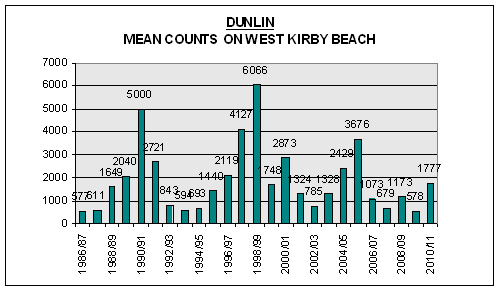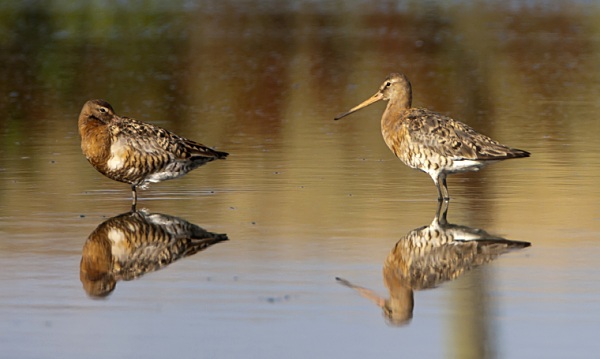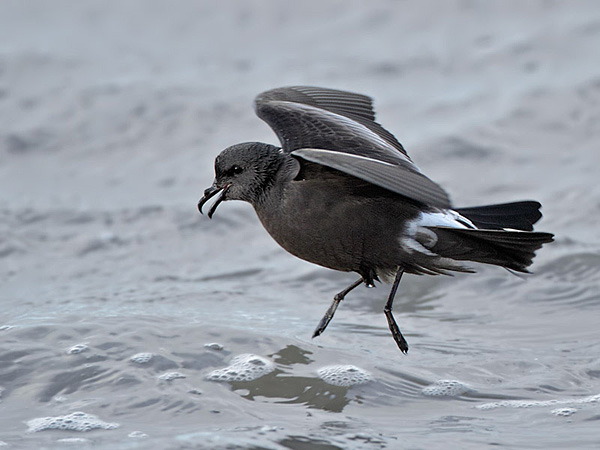Site menu:

September 2011 Newsletter
West Kirby High Tide Roost - 2010/11.
August Bird News.
Forthcoming Events.
Latest Newsletter.
West Kirby High Tide Roost 2010/11

The winter of 2010/11 was a good one for the West Kirby high tide roost. We had the highest mean count of Curlew and the third highest mean count of Oystercatchers in 24 years, the highest mean count of Bar-tailed Godwits for the past 12 years and the highest mean count of Sanderling for the past five years, with several other wader species also in good numbers. Additionally, on several high tides we had fantastic views of the Brent Geese flock coming right onto the marsh, and even onto the shore path, including a record high count for the Dee Estuary of 212 on January 23rd.
But perhaps the most memorable event of that winter was the exceptionally cold weather in December. This resulted in some great birdwatching including seeing most of the roosting flock floating on sea ice as the tide came in! I've said in the past, somewhat tongue in cheek, that you could tell the temperature by counting the numbers of Knot on the estuary - the colder it is the more we seem to get. There was certainly some sort of a correlation over these past two winters as demonstrated in the graph below; the cold weather in January 2010, and the even colder weather in December 2010, resulting in a marked spike in Knot numbers.

How is all this data gathered? It is all done by the Dee Estuary Voluntary Wardens who are down on West Kirby shore at every high tide of 8.8m or over from mid-September to mid-March. This coming winter (2011/12) marks the 25th anniversary of this scheme - the longest running of its type in the country. Although we thoroughly enjoy counting the birds and the birdwatching, our main job is to protect the wader roost from unnecessary disturbance. We do this by asking people to avoid walking too close to the wader flocks and to keep their dogs under control, and similarly for other users of the beach such as horse riders. We have a system of yellow marker buoys so the wind and kite surfers know where they can sail without disturbing the roost. Through a series of leaflets and posters we try and educate the general public. One of the most pleasurable ways of doing this is just to let passers-by look at the birds through our telescopes - the gasps of amazement when they see the birds close-to certainly makes our job worthwhile!
We
are always on the lookout for new wardens, if you are
interested please either contact myself by email at :
![]() , or ring Lynne Greenstreet, the Coastal
Ranger, on 0151
648 4371. Feel free just to come down for a chat when we are wardening
if you just want to see what we do.
, or ring Lynne Greenstreet, the Coastal
Ranger, on 0151
648 4371. Feel free just to come down for a chat when we are wardening
if you just want to see what we do.

1. West Kirby High Tide Wader Roost 2004/05.
2. West Kirby High Tide Wader Roost (this article goes into details about the cyclic pattern).
3. Dee Estuary Voluntary Wardens at West Kirby (article published on the occasion of our 20th anniversary).
4. Dee Estuary Voluntary Wardens.
I should just add that we operate with the full help and support of the Wirral Ranger Service (Wirral Borough Council) for which many thanks, also thanks to the RSPB and Nature Conservancy (as it was called then) for the help in setting the scheme up in the first place.
Richard Smith (Dee Estuary Voluntary Warden).
Note graphs copyright of Dee Estuary Voluntary Wardens.

August Bird News


see 'From the Muddy Banks of the Dee' Blog.
The raptor of the month was undoubtedly a Black Kite seen flying west past the mouth of the estuary on the 25th. An Osprey flew over Heswall on the 27th. There were five reports of Marsh Harriers including two at Inner Marsh Farm on the 20th, two Garganey were here on the 10th. 19 Common Buzzards flew over Hoylake Langfields on the 17th, they were seen 'kettling' over Greasby before heading towards Hoylake but we couldn't see where they went from there. A Great White Egret was reported on Parkgate Marsh on the 18th but not confirmed. 175 Great Crested Grebes off Hoylake on the 4th was an excellent count for this time of year.
Richard Smith.What to expect in September
The last two Septembers were amongst the best in living memory, but they aren't always like this and plenty are virtually windless with a consequent lack of interesting sea birds. So what we need are strong north-westerly winds, preferably gale force, for several days. Having said that, even a calm September can have a good selection of rarities such as a marsh tern or two, and perhaps a rare wader.
Rather than summarise here the last two Septembers I'll just link you back to the newsletters describing what happened - Leach's Petrels 2010 article, September 2010 Bird News, September 2009 Bird News.
Just one more thing to add - there are some high spring tides at the end of the month, the first of the autumn (see below). If we get strong westerly winds it will be difficult to know whether to stay on the Liverpool Bay coast or go to Parkgate! A Leach's Petrel over the marsh at Parkgate would be rather nice.

Forthcoming Events
September Highest Spring Tides (Liverpool)
Also see Tides
page.
28th September, 12.14hrs (BST), 10.0m.
29th September, 12.57hrs (BST), 10.0m.
30th September, 13.39hrs (BST), 9.9m.
Forthcoming Events
Organised by the Wirral
Ranger Service , Flintshire Countryside Service and/or the
RSPB:
All these events and walks have bird interest, even those not
advertised specifically for birdwatching. No need to book for these
events unless specified - please check below.
Also see 2011 Events Diary.
Thursday 1st September, 11:00 am start, 40
Years of Ramsar – An eye on the Mudflats.
Join
the Rangers and members of the Wirral Country Park Recording Group for
a special look at the Dee estuary to celebrate the 40th anniversary of
the signing of the Ramsar Convention that protects internationally
important wetlands. As the tide rises plenty of wetland birds will be
on the move and we will track them with the new remote “mud-cam” out on
the flats and our screen with us on the shore. High tide 2.03pm.
Binoculars/telescopes will be available.
Meet at Banks Rd car park,
Lower Heswall (next to Sheldrake's Restaurant).
For further enquiries ring 0151 648 4371.
The BIG
DEE DAY (Celebrate 40 years of Ramsar) - Wirral Country
Park at Thurstaston.
Friday 16th and Saturday 17th September, 10:00 am to 4 pm.
Events on Friday include:
1. Dee Estuary Voluntary Wardens slideshow and information display in
the lecture theatre.
2. Ladybird surveys by well known local naturalist Jeff Clarke. Jeff's
commentary on whatever he is doing is always entertaining and full of
fascinating facts about what he is observing.
3. At 3pm there will be an hour long talk by Ranger, keen
birdwatcher and photographer Matt Thomas in the theatre called “Grey
Skies & Redshanks – autumn through winter on the Dee
Estuary".
Events on Saturday include:
1. Dee Estuary Voluntary Wardens slideshow and information display in
the lecture theatre.
2.
A Birdwatching guided walk at 12pm
from the Visitor Centre to Heswall and back looking at the Dee estuary.
Many birds are back in their hundreds making for a spectacular sight as
the tide comes in.
3. At 3pm there
will be an hour long talk by Ranger, keen birdwatcher and
photographer
Matt Thomas in the theatre called “Grey Skies & Redshanks –
autumn
through winter on the Dee Estuary".
For further enquiries ring 0151 648 4371.
On the Welsh side of the estuary the BIG DEE DAY will be a 48 hour marathon of cleaning, clearing and celebration of the Dee Estuary. Please ring Wepre Park on 01244814932 for details.
Sunday 25th September, 5.30pm start, RSPB
Raptor Watch at the Old
Baths Car Park, Parkgate.
The
Dee Estuary Nature Reserve is a vital wintering grounds for many birds
of prey – Discover these impressive birds in their wild habitat,
hunting and roosting on the saltmarsh.
Warm clothing and binoculars recommended. Ring 0151 336 7681 for
further information.
NOTE - Ramsar Marsh-Cam
event advertised for Tuesday 27th September is actually on Thursday
27th October!!
Saturday 22nd October 10:00 am until 3:30
pm. Low tide Birdwatch on Hilbre.
Join the Rangers and staff from the RSPB for a low tide visit to Hilbre
Island. We should encounter a good variety of waders as they feed on
the outgoing tide. Warm clothing and suitable footwear are
essential. Sorry no dogs. Please book early as
there are limited places available. For booking and further enquiries
call: 0151 648 4371.
Thursday 27th October, 9:00am start (high
tide 11.30am), 40 Years of
Ramsar – Marsh-Cam.
Join the Rangers and members of the Wirral Country Park Recording Group
for a high tide birdwatch at the
Riverbank Road car park (Lower Heswall) looking out over the
marshes.
As well as the telescopes we will be deploying our remote marsh cam to
keep tabs on the birds as the tide pushes them around.
Binoculars/telescopes available.
For further enquiries telephone: 0151 648 4371.
Sunday 30th October, 3pm start, RSPB
Raptor Watch at the Old
Baths Car Park, Parkgate.
The
Dee Estuary Nature Reserve is a vital wintering grounds for many birds
of prey – Discover these impressive birds in their wild habitat,
hunting and roosting on the saltmarsh.
Warm clothing and binoculars recommended. Ring 0151 336 7681 for
further information.
|
 |
The blank (UK) Birding Webring is a collection of quality birding web sites that are based in the United Kingdom. Visit the webring homepage for more information, or A complete list of all the sites in the webring is available by clicking here. previous site in ring : random site in ring : next site in ring |